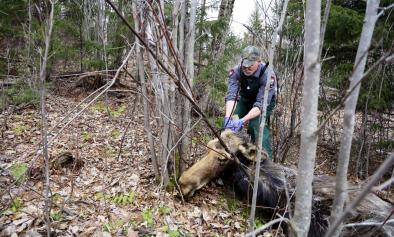Climate change increases cross-species viral transmission risk
Study key findings & significance
- This is the first comprehensive assessment of how climate change will restructure the global mammalian virome (the collection of viruses found among mammals), focusing on geographic range shifts.
- Even under the most optimistic climate scenarios, the coming decades will see roughly 300,000 first encounters between species that normally don’t interact, leading to about 15,000 spillovers wherein viruses enter naive hosts.
- Of particular concern is that animal habitats will move disproportionately in the same places as human settlements, creating new hotspots of spillover risk. Much of this process may already be underway in today's 1.2 degrees warmer world, and efforts to reduce greenhouse gas emissions may not stop these events from unfolding.
- The study suggests that climate change is becoming the biggest upstream risk factor for disease emergence—exceeding higher-profile issues like deforestation, wildlife trade, and industrial agriculture.
Author quotes
“The moment to stop climate change from increasing viral transmission was 15 years ago. We’re in a world that’s 1.2 degrees warmer [than preindustrial levels], and there is no backpedaling. We have to prepare for more pandemics because of it.”
Colin Carlson, lead author and assistant research professor at the Center for Global Health Science and Security at Georgetown University Medical Center
The revelations are “so large and heavy to behold that even as we were writing them, we didn’t want to."
Abstract
At least 10,000 virus species have the capacity to infect humans, but at present, the vast majority are circulating silently in wild mammals. However, climate and land use change will produce novel opportunities for viral sharing among previously geographically-isolated species of wildlife. In some cases, this will facilitate zoonotic spillover—a mechanistic link between global environmental change and disease emergence. Here, we simulate potential hotspots of future viral sharing, using a phylogeographic model of the mammal-virus network, and projections of geographic range shifts for 3,139 mammal species under climate change and land use scenarios for the year 2070. We predict that species will aggregate in new combinations at high elevations, in biodiversity hotspots, and in areas of high human population density in Asia and Africa, driving the novel cross-species transmission of their viruses an estimated 4,000 times. Because of their unique dispersal capacity, bats account for the majority of novel viral sharing, and are likely to share viruses along evolutionary pathways that will facilitate future emergence in humans. Surprisingly, we find that this ecological transition may already be underway, and holding warming under 2°C within the century will not reduce future viral sharing. Our findings highlight an urgent need to pair viral surveillance and discovery efforts with biodiversity surveys tracking species’ range shifts, especially in tropical regions that harbor the most zoonoses and are experiencing rapid warming.
Related Content



